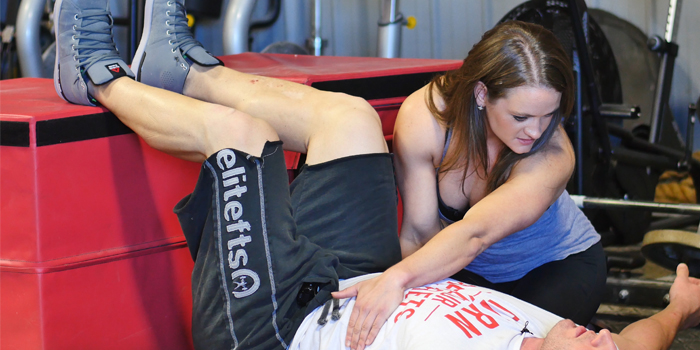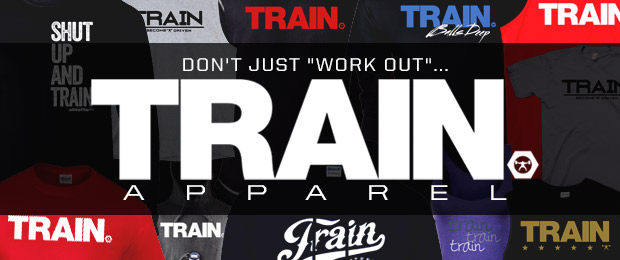
When it comes to staying healthy under a bar or with general fitness, it’s pretty standard to think about integration: muscles functioning together with appropriate timing and synchronicity to provide either stability or movement in all three planes.
In general, it seems coaches and athletes alike are recognizing that while there’s a time and place for isolation in prehab and/or rehab, most of the time, giving the body an opportunity to integrate patterns together is one of the better ways to promote high-quality movement with proficiency. But we still think regionally, associating upper body structures with other upper body patterns, rather than integrating upper and lower together. Ultimately, a change or loss of position under load (especially a symmetrically loaded barbell) will often alter both upper and lower body mechanics, so selecting one to two exercises to utilize in your programming that address both is a high-reward decision.
RECENT: Romanian Deadlifts Revisited: How to Appropriately Apply The Hinge
The Kettlebell Windmill is one of the best and most popular exercises for integrating proper shoulder mechanics with torso control and ribcage position. We think of it as a largely upper body exercise, but I’d like to make a case that it’s one of the most underutilized exercises to promote hip loading and control bilaterally.
In fact, most times when I see someone unable to move proficiently in this exercise, the issue comes from the hips/pelvis either having extensibility through the adductors to permit frontal plane shift (think of this as “sending” to the other side), or poor ability to access and control from the posterolateral hip (the analog “receiving” side). These motions occur on opposite sides of the body at the same time.
Even unloaded, this exercise requires control in the frontal, transverse, and sagittal planes: check, check, and check, for tri-planar control, plus we’re integrating upper and lower body for improved stability and control.
When it comes to performing the Kettlebell Windmill, the biggest issues I see, as I’ve mentioned, fall into the category of being unable to integrate a hinge position into the posterior hip. Culturally, we live in a world where we don’t often use the posterior hip fully: it’s one of the reasons you’ll see FRS or FRC practitioners get such great results with restoring neural control and proprioception of the area by reclaiming joint real estate.
Positions that tighten or eat up range of motion in the posterior hip are a combined flexion, adduction, and internal rotation, which is a (surprise) tri-planar windup of the anatomy of the hip capsule. Often, when we don’t access a joint capsule’s range of motion, the surrounding musculature (deep hip rotators, in this case) can become oriented or tight in that position.
Very general cues for performing the exercise include rotating the toes toward the front leg, some people say, up to 45 degrees. Recognize that with the toes rotated, you’re orienting the back leg into a position of hip internal rotation, where people are often limited. As you shift into that hip, you’re also permitting your center of gravity to begin to shift that direction or slightly adduct in the frontal plane.
We’ll add the third component of hip flexion, and you can start to see where the combined mobility and stability demands are actually relatively high in this exercise for the “on” hip. For the front hip, there’s additional mobility required for the opposite directions… all while also encouraging thoracic rotation and everything going on above the beltline, so to speak.
Common mistakes I see with the Kettlebell Windmill, related to below the ribcage:
- Flexing at the lumbar spine, not the hip.
- Rotating through the lumbar spine rather than the hip, especially as they begin to reach the front hand down.
- Side-bending rather than shifting and loading the hip. You should be seeing a trend here that the inability to move through the hip means you will accomplish the task by moving through another region.
- Being too strict with leg position rather than quality of movement. Certain mobility restrictions should be worked into over time. Purists out there might hang me for saying this, but if a client has difficulty loading the hip but can start to navigate that motion if I let them bend their front knee a bit, I’m going to let them bend their daggum knee, for now, with a teaching emphasis placed on hip loading and gradually progress to straight legs.
- Using too much range of motion: If you’re strict with yourself and your clients, you might find that as they reach further towards the floor (and working into positions that require greater degrees of hip mobility in the wind-up pattern), they will start substituting trunk motion for hip motion.
You may find that when you buckle down, hip control and mobility are more limiting factors than you thought. Here are a few regressions that you can utilize to improve movement quality:
- Half-kneel: The pattern here is virtually the same, and your range can be modified to bring your palm to the floor or forearm to the floor with the caveat that the whole purpose of regressing is to improve movement quality.
- Take to unilateral hinge with rotation (foot elevated): By elevating the back foot, you’re encouraging posterior shifting provided your weight remains through that foot. Proprioceptively, there’s a neurological shift that happens by placing a block or mat underneath the back foot. If someone can own a hinge position here, begin working into rotation or adjust foot position so that they have to control the frontal plane more intentionally.
- Change the location of weight: With a traditional (or even bottoms-up) windmill, the weight is used on the up arm. Changing the weight location to the down arm can assist in loading the back hip. Clients can often proprioceptively feel glutes and hamstrings working effectively to return to the start position as well. The more someone can proprioceptively feel, the easier it can be to integrate that motion without requiring as much intent.
- Change knee angle: The highest level of technical proficiency with this movement maintains the front leg as straight. Most people don’t have the requisite mobility to perform this and truly shift (or receive weight) into the opposite side when first beginning this exercise. Straight leg is a goal, but as I’d mentioned earlier, either neurogenic or (less often) mechanical tightness in the adductors and hamstrings can make this difficult. If there are two challenging components (posterior shift/adduction onto one side and extensibility of the opposite side), I’ll let the client bend their front knee and incorporate other exercises to improve the other difficult component.
Task simplification and practice lead to movement ownership. That ownership must then be integrated to mastery. Don’t be afraid to break things down and recognize that often a purist line of thought might correlate to a high-skill task that is either too difficult or perhaps inappropriate for your particular client.
RELATED: How to Effectively Train Core Strength
Once you’ve owned this ability to shift, the Kettlebell Windmill has a huge number of variations as well as loading schemes that can be tailored to meet the athlete’s goals, and I’d venture to say, provide some improvement to most people’s Big Three if load/volume is appropriately matched to the athlete’s need (stability, strength, muscular endurance).
If you really want to change someone’s ability to access posterior hip real estate, you can integrate some breathing, as purported by the folks over at Postural Restoration Institute, to encourage appropriate pelvic floor and deep hip rotator tonicity. If you want power out of the hole in your squat, giving your pelvic floor the opportunity to find appropriate tonicity at the right time is absolutely a game-changer.
Keep in mind that while we glamorize mobility for feeling good in life, your ability to appropriately use and access ranges of motion in somewhat high-skill tasks is going to permit greater stability under load. More stability through appropriate range of motion will generally equate to higher force production, the ability to handle more weight, and let you train at a level that permits access to higher threshold motor units, more size, more strength… you see where I’m going, and it’s the same direction you and your clients want to be headed in.
Simple concepts applied slightly outside your normal way of thinking can lead to a huge payoff.










